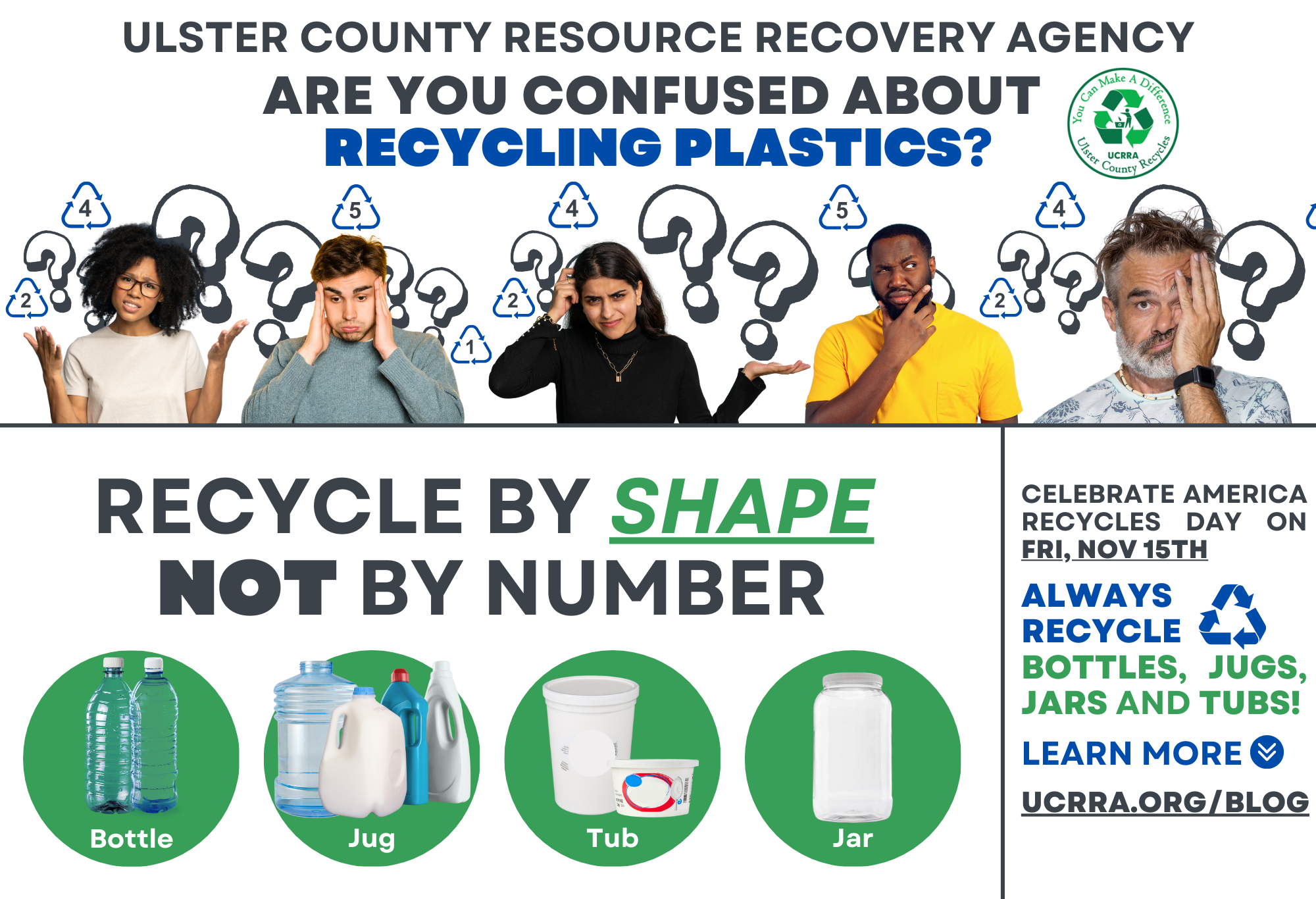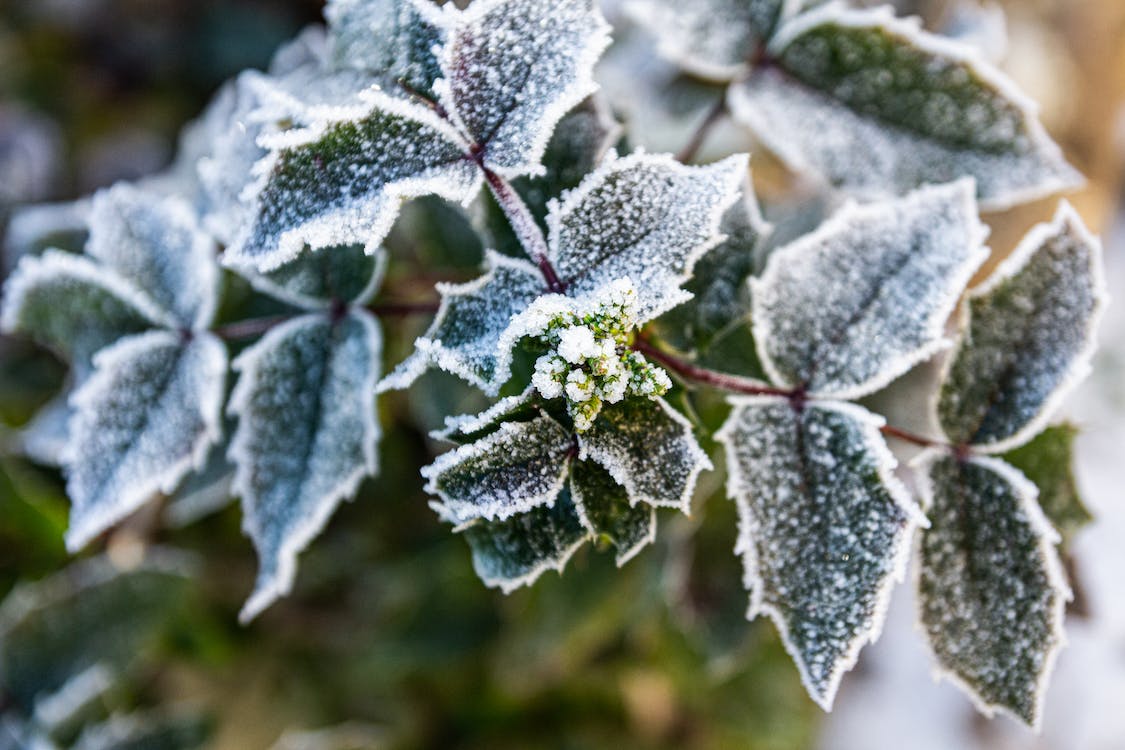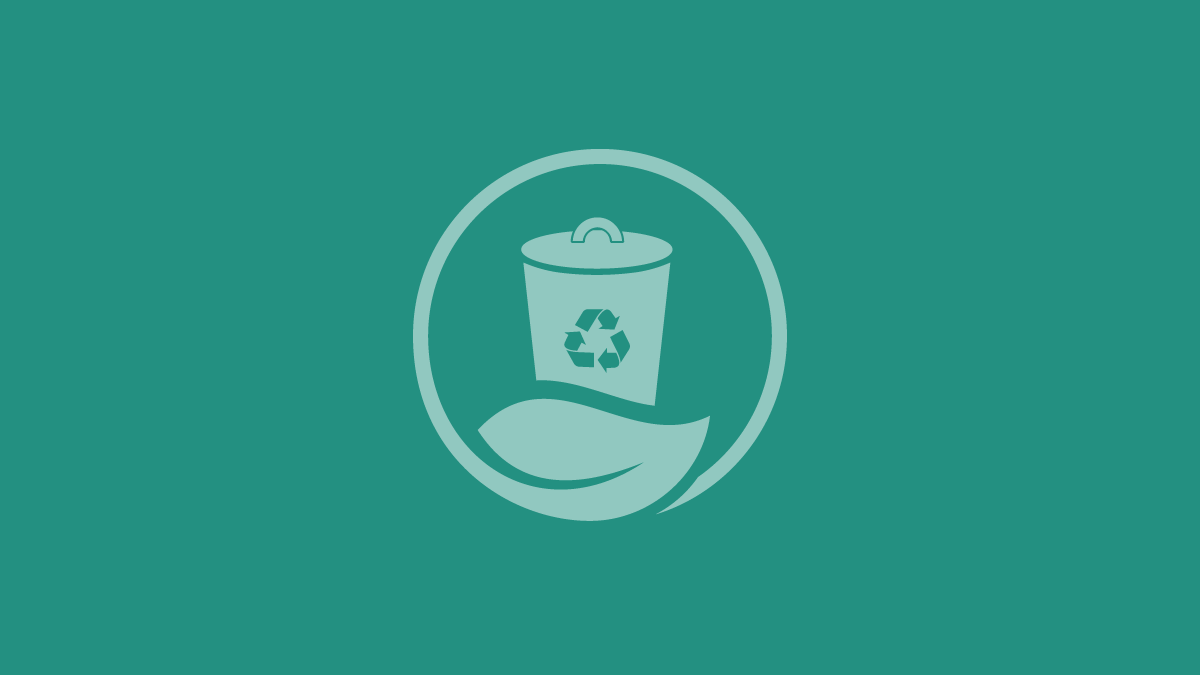
Blog by Angelina Brandt, Director of Sustainability
November 6th 2024
America Recycles Day (ARD) is nationally celebrated on November 15th to spread the word about how recycling helps reduce waste, save energy, and conserve precious resources. But America Recycles Day isn’t just a one-day celebration – it’s an opportunity to look at your recycling habits and find ways to grow your impact.
Local recycling is widely successful in so many ways; Ulster County Resource Recovery Agency recycled over 8.4 million pounds of regulated recycling last year, the equivalent weight of two Giant Sequoia trees in just paper and cardboard alone, and enough plastic equivalent to the weight of two and a half blue whales! All across Ulster County, commercial and residential programs recovered over 55 million pounds of plastic, glass, metal, and paper products!
Despite this, all across America, it’s clear we’re not recovering as much recycling as we could be, due to lack of access to recycling services, or an “engagement gap” where people are just not sure what can go in the bin or choose not to recycle as often as they could. This year, our Recycling Outreach Team is celebrating ARD by sharing recycling leadership tips to increase recycling capture wherever you are – at home, at work – or out at events in the community, so that we can achieve even greater success and recycling milestones.

Did you know that about 40% of the total recycling in New York State is generated by homes and households? Living with family members or roommates who aren’t quite on the recycling train can feel like trying to convince a cat to take a bath! Here are some ideas for how to gently encourage better recycling habits to those sharing your living space:
1. Set Up Clearly Labeled Bins
Convenience is key! Set up bins in areas where you’re most likely to generate recyclables, especially in the kitchen, bathroom, or other shared spaces. Recycling bins should look different from trash bins, which can be achieved by using a different color or size for the recycling bin. Making sure there’s always an easy and obvious way to recycle is essential. To clear any confusion, simply hang a copy of your local recycling guidelines above the bin to show what can go in. If you’re not exactly sure what to recycle, contact your service provider if you have curbside collection or use our Dual Stream Recycling Guide if you live in the City of Kingston or use your local town transfer station.
Want to up your sorting station even more? Once you’ve mastered recycling bottles and cans, you might consider adding other sorting bins for things like film plastic bags to return on your next grocery haul- or old clothing than can donated once the bin is full – or a designated bin for scrap metal that can be junked for cash. Since these bins may be used less often, some households will set up these stations in a central location like a laundry room, garage, or shed.
2. Make Recycling Part of the Family Routine
Setting up a daily rhythm (like making coffee or feeding the pets) can help make recycling at home become second nature. If everyone knows the routine, they’re less likely to skip it. Try this: “Let’s make a deal: after dinner and before we hit the couch to binge watch our favorite show, let’s take five minutes to do a quick sweep for any recyclables. It’ll be like our pre-movie night ritual!”
3. Create a “Recycling Wall of Fame”
A fun and visible reminder can make recycling feel like a team sport instead of a chore. Prompt your family or room mates by saying something like “Hey guys, check out this Recycling Wall of Fame! Every time you recycle something correctly, take out the recycling, or get your guest to recycle correctly, your photo will go up here for the week!”
You can also reverse this, to make a “Recycling Wall of Shame” turning those wishcycled items into little teachable moments. Lighthearted and non-judgmental reminders (like funny sticky notes) will help guide your housemates in the right direction without guilt or shame. For example, a note like “Oops, looks like the yogurt container didn’t make it into the bin! You’re doing great, just remember the cup must be rinsed empty and then it can go into recycling” feels encouraging without being nagging or singling out a particular person for what they did wrong. The more you make it engaging or entertaining, the more motivated everyone will feel!

If you want to become a champion of recycling leadership and advocacy, please consider joining the call to action in support of Statewide EPR Policy for paper and packaging. EPR, or Extended Producer Responsibility, is an environmental policy approach in which a producer’s responsibility for a product is extended to the post-consumer stage of a product’s lifecycle. EPR policy is characterized by shifting responsibility upstream toward the producer and away from municipalities and incentives for producers to take into account environmental considerations when designing their products. Five U.S. states have successfully enacted packaging EPR bills with demonstrated results increasing those state’s recycling rates. New York is among six other states that are still actively working towards passing EPR policy for packaging. Urge the Senate, Assembly, and Governor to pass the Packaging Reduction and Recycling Infrastructure Act (PRRIA), S.4246-B (Harckham)/A.5322-B (Glick). Learn more here.
If you enjoyed this blog, check out our other tips for recycling at work – or out at events in the community.
Have questions about recycling? Check out some Frequently Asked Questions below!
If you’d like to bring recycling education to your office, school, or group, our Recycling Outreach Team can help! Contact us to set up a tour, a site visit, or a guest speaker to share about the benefits of recycling.
Give your recyclable items (such as bottles, jugs, jars, tubs, etc.) a quick and thorough rinse to remove any excessive food or liquid residue. Never recycle containers that are full or partially full of food or liquid. Containers should be empty and relatively clean, but don’t have to be perfectly sparkling clean! Ensuring your containers are clean is the most sanitary way to recycle so that your recycling bin stays clean, and reduces odor and pests, and keeps high quality of the other items you recycle.
Although sometimes labeled with a recycling symbol, or even the numbers “1” and “2”, black plastic is generally not recycled in New York State. Despite this, 63% of Americans believe that black plastic is recyclable.
Here’s why it’s not recyclable:
1. Black plastics blend in with conveyor belts in single stream recycling centers, and therefore they do not reflect light which means they cannot be identified and sorted by the optical scanners used at recycling facilities.
2. There is currently no market for recycled black plastic. It’s an undesirable feedstock for manufacturers because black plastic, once chipped or flaked into pellets, cannot be used to make packaging of any other color, which decreases its value in the recycling marketplace.
Not only is black plastic tricky to recycle but it can also be a threat to our health. A great deal of black plastic is manufactured using electronic waste or e-waste. E-waste often contains toxic elements such as bromine, chromium, and lead. This can be troubling for humans especially if e-waste is being recycled into items that we come into close contact with, such as single-use food packaging, like to-go containers and coffee cup lids.
The next time you come across black plastic, consider how you can avoid it.
Recycle by shape, not by number. The number printed on plastic objects is called a resin identification code, and is used to identify the type of plastic an object is made from; a number or a recycling symbol (chasing arrows) do not mean it is recyclable. Increasingly, the shape of a plastic object is the best indicator of recyclability. The most recyclable shapes are bottles, jugs, jars, tubs, and their lids. However, recycling rules can vary so be sure to ask your service provider for guidelines.
Although the number (resin code) does not indicate recyclability, here’s some more information about the resin types and some common objects and products made from that type of plastic.
Number 1 – PETE (Polyethylene terephthalate):
Soda bottles, water bottles, condiment bottles, etc.
Number 2 – HDPE (High-density Polyethylene):
Containers for: colored laundry/dish detergent jugs, clear water/milk jugs, shampoo/conditioner bottles, etc.
Number 3 – V (Polyvinyl chloride):
Pipes, shower curtains, clear medical tubing, vinyl dashboards and seat covers.
Number 4 – LDPE (Low-density Polyethylene):
Wrapping films, grocery bags, and sandwich bags.
Number 5 – PP (Polypropylene):
Tupperware, yogurt tubs, plastic caps of soda bottles, etc.
Number 6 – PS (Polystyrene):
Plastic cups, disposable cutlery and cups (clear and colored), coffee cups, packing peanuts, Styrofoam insulation.
Number 7 – OTHER:
These are made of any combination of 1-6 or other, less commonly used plastics/resins.
‘Single Stream Recycling’ refers to when all recyclable items are placed into one bin for collection. Users do not need to further separate items into any subcategories.
‘Dual Stream Recycling’ refers to when users need to separate recyclable items into subcategories – like mixed paper and commingled containers (plastic, glass & metal).
At recycling centers, recyclable materials are sorted both mechanically and by hand. The types of processing equipment at recycling centers can vary. Single stream recycling facilities often have more specialized machines to sort through the complex stream of recyclables mechanically.
UCRRA processes dual stream recycling only. If you utilize a Single Stream curbside recycling service, please contact your hauler for a list of accepted items.
Recycling programs can vary. It’s important to know your local program for many reasons! In order for recycling to be truly successful and sustainable, the industry must reduce contamination. This means keeping recyclable items clean, dry, free of food and liquid, but it also means making sure undesirable items are not mixed in with the recycling stream. Putting items in the recycling bin when you’re not actually sure they are accepted in your recycling program is called ‘wishcycling’ and this can lead to damaged equipment, injured workers, lost efficiencies in time management, which leads to financial losses for recyclers. In some cases, contaminated loads of recycling are no longer marketable to manufacturers. These are some of the reasons it’s important to know your program! When in doubt, ask!
The Ulster County Mandatory Source Separation and Recycling Law, Local Law Number 4 of 2010, establishes regulated recyclables materials and requires all persons in Ulster County to source-separate those materials for recycling.
As defined by the law, “Person” shall mean “any natural person, individual, association, owner or manager of a business, commercial or industrial establishment, joint venture, corporation, trust, estate, institution, not-for-profit organization or any other legal entity including a municipality or any other waste generator.”
It is considered an unlawful act for any person to discard or fail to separate regulated recyclable materials. Please contact us to report any instances of noncompliance.
Recyclables that arrive to UCRRA are consolidated, then sorted into subcategories based on recycling market specifications. Each of the sorted categories is then baled into large cubes, weighing 1200-1500 lbs. per bale. UCRRA sells these recyclables in bulk as commodities. The price per lb. and the end user (or buyers of these materials) are subject to change on a monthly basis according to market conditions. Commodities may be resold several times after they leave UCRRA or before they becomes turned into a new product or consumer good. Most of the recyclables sorted by UCRRA are sold to recyclers in North America.
If you have a curbside collection program that is single-stream, your recycling does not come to UCRRA.
In short, PET thermoforms behave differently than bottles as a result of some basic properties of the thermoform material. Currently, in the recycling markets across the US and Canada, there is a 5-10% thermoform threshold in place. This means that for every bale of recyclable plastic, depending on the buyer, only 5-10% of it can be thermoform plastics. If the amount of thermoforms goes beyond this number, the bale is at risk of being discarded in the trash instead of moving along in the process to continue being recycled.
In order for recycling systems to be sustainable, and recyclers to bring high quality sorted material to end markets that will purchase it and manufacture new goods, recycling facilities must meet the high quality standards of the buyers. Clamshell containers are also commonly contaminated by food residues, which makes them a lower quality grade of plastic. These containers are also ‘lightweighted’ which makes them compress flat during processing and in single-stream systems, they can be mistakenly sorted as 2-D rather than 3-D objects and contaminate the mixed paper streams.
UCRRA operates a dual stream recycling center and does not process ‘single stream recycling’. If you utilize a curbside hauling service, please contact the company directly.
Yes, caps and lids are recyclable.
Keep the lids and caps on if the container, lid, or cap are the same material (for example, a plastic lid on a plastic bottle). Please remove the lid if the materials differ (for example, a glass bottle with a metal lid). These guidelines pertain to Ulster County residents that utilize their Town Transfer Station. If you have curbside recycling collection, please contact your hauler for their recycling guidelines.
Pizza boxes are widely considered to be not recyclable because they are typically very soiled by food and grease. Pizza boxes are not accepted in the recycling program at UCRRA or at the town transfer stations in Ulster County. If you have a hauler please contact them for instructions.
Call UCRRA (845) 336-3336 or fill out our online form to Report Non-Recycling.


